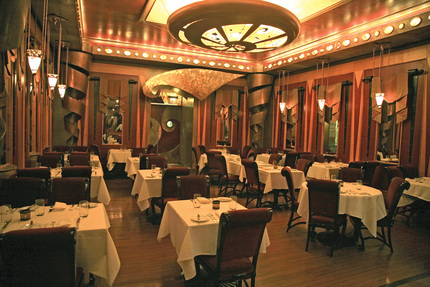
With the National Restaurant Show in town, it’s perfectly understandable that many visitors will be scouring the neighborhoods and haunting hostess stands this week in search of an indelible experience at some of the hottest new spots. But Chicago was a happening restaurant scene long before the latest trendy places started garnering so much notice. So perhaps instead of trying to fight the crowds at the latest hip additions, maybe this is a good time to revisit the old-school places that have served as that scene’s foundation for decades or more.
The Berghoff (1898)
The undisputed king of the city’s historic dining firmament.
17 W. Adams Street; 312/427-3170.
The Walnut Room (1907)
A must-stop for visitors around the holidays – when the handsome formal dining room inside of the Macy’s flagship store is arranged around the gargantuan Great Tree and the line of tradition-seekers stretches far out the door – this Chicago classic also happens to be a wonderful spot to check out during the far less hectic 11-month “off-season” as well.
111 N. State Street; 312/781-3125.
Italian Village (1927)
Three distinct Italian experiences under one historic roof (pictured above).
71 W. Monroe Street; 312/332-7005.
Cape Code Room (1933)
Once upon a time, if you were staying at the ritzy Drake Hotel overlooking Lake Shore Drive, there was no question about where you’d be getting your evening meal; these days, if it’s a classic New England-style seafood spread you’re after, there still isn’t.
140 E. Walton Place; 312/787-2200.
Billy Goat Tavern (1934)
This subterranean outlet of the “cheezborger” mini-chain only dates back to 1964, but that has been more than enough time for it to ensconce itself in the collective lore of some of the city’s most colorful characters.
430 N. Michigan Avenue; 312/222-1525.
Gene and Georgetti (1941)
In a meat-and-potatoes town, the classic Chicago steakhouse.
500 N. Franklin Street; 312/527-3718.
Artist’s Café (1961)
It seems only fitting that the street level space of a historically significant, egalitarian gem like the Fine Arts Building would be occupied by a similarly historic and artsy gathering place for musicians, painters, businessmen and passersby to linger over a three-egg omelet or a rich chocolate malted.
412 S. Michigan Avenue; 312/939-7855.
Su Casa (1963)
While the huddled masses wait out the 90-minute queues for a taste of Chicago deep-dish a couple of blocks over, those looking to avoid the crowds can instead opt for some straightforward Mexican fare from the same longtime proprietors of those famous pizza palaces.
49 E. Ontario Street; 312/943-4041.
Manny’s Cafeteria and Delicatessen (1964)
The Everyman granddaddy of Chicago lunch counters.
1141 S. Jefferson Street; 312/939-2855.
Chicago Brauhaus (1965)
This traditional German beer hall has been the unofficial centerpiece of the Lincoln Square neighborhood for more than four decades.
4732 N. Lincoln Avenue; 773/784-4444.
The Berghoff (1898)
The undisputed king of the city’s historic dining firmament.
17 W. Adams Street; 312/427-3170.
The Walnut Room (1907)
A must-stop for visitors around the holidays – when the handsome formal dining room inside of the Macy’s flagship store is arranged around the gargantuan Great Tree and the line of tradition-seekers stretches far out the door – this Chicago classic also happens to be a wonderful spot to check out during the far less hectic 11-month “off-season” as well.
111 N. State Street; 312/781-3125.
Italian Village (1927)
Three distinct Italian experiences under one historic roof (pictured above).
71 W. Monroe Street; 312/332-7005.
Cape Code Room (1933)
Once upon a time, if you were staying at the ritzy Drake Hotel overlooking Lake Shore Drive, there was no question about where you’d be getting your evening meal; these days, if it’s a classic New England-style seafood spread you’re after, there still isn’t.
140 E. Walton Place; 312/787-2200.
Billy Goat Tavern (1934)
This subterranean outlet of the “cheezborger” mini-chain only dates back to 1964, but that has been more than enough time for it to ensconce itself in the collective lore of some of the city’s most colorful characters.
430 N. Michigan Avenue; 312/222-1525.
Gene and Georgetti (1941)
In a meat-and-potatoes town, the classic Chicago steakhouse.
500 N. Franklin Street; 312/527-3718.
Artist’s Café (1961)
It seems only fitting that the street level space of a historically significant, egalitarian gem like the Fine Arts Building would be occupied by a similarly historic and artsy gathering place for musicians, painters, businessmen and passersby to linger over a three-egg omelet or a rich chocolate malted.
412 S. Michigan Avenue; 312/939-7855.
Su Casa (1963)
While the huddled masses wait out the 90-minute queues for a taste of Chicago deep-dish a couple of blocks over, those looking to avoid the crowds can instead opt for some straightforward Mexican fare from the same longtime proprietors of those famous pizza palaces.
49 E. Ontario Street; 312/943-4041.
Manny’s Cafeteria and Delicatessen (1964)
The Everyman granddaddy of Chicago lunch counters.
1141 S. Jefferson Street; 312/939-2855.
Chicago Brauhaus (1965)
This traditional German beer hall has been the unofficial centerpiece of the Lincoln Square neighborhood for more than four decades.
4732 N. Lincoln Avenue; 773/784-4444.

 RSS Feed
RSS Feed
